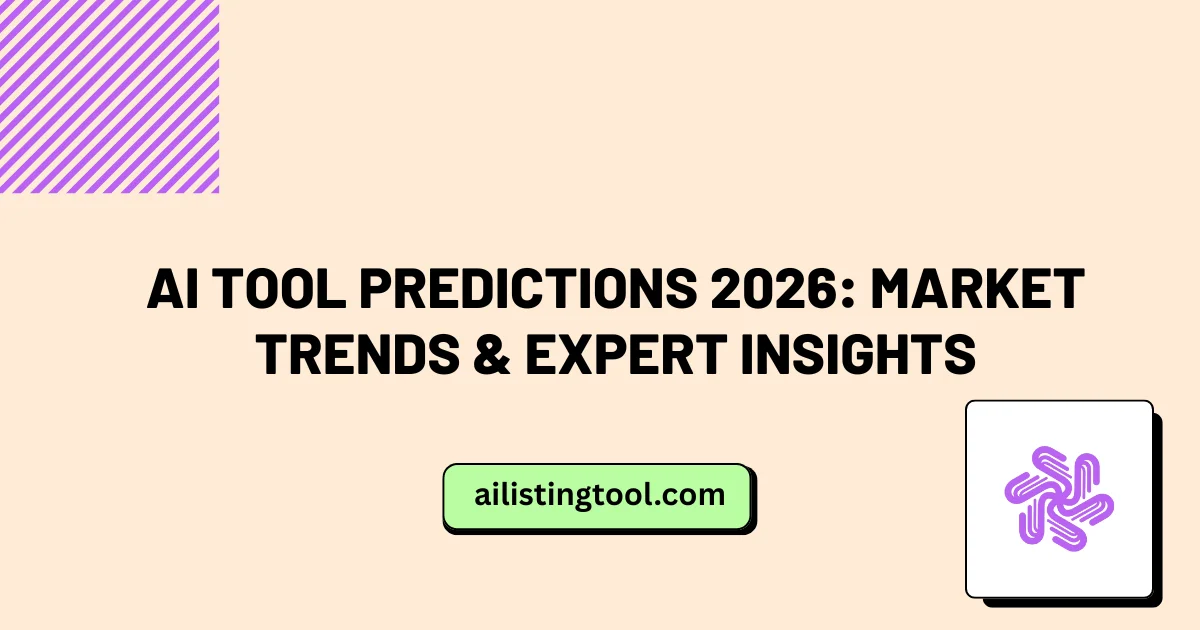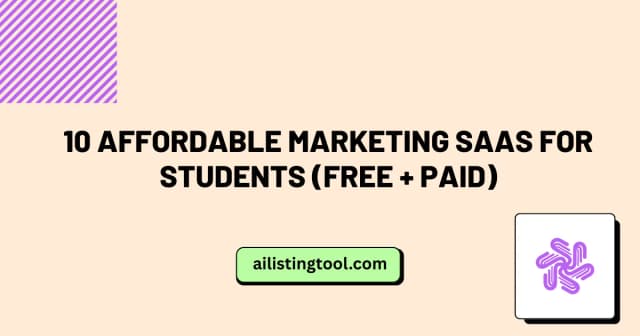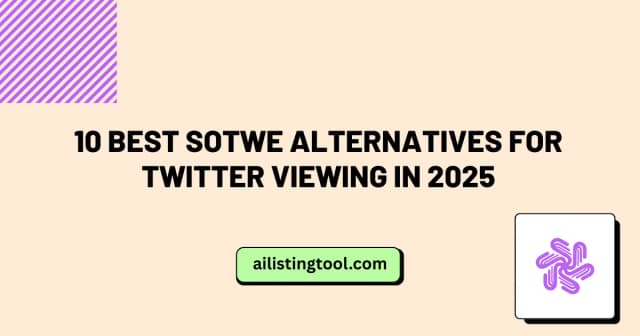AI Tool Predictions 2026: Market Trends & Expert Insights

The AI software market stands at an inflection point. After the explosive growth of 2023-2025, businesses are asking: what comes next? Based on current market signals, expert analysis, and emerging patterns, here’s what we’re seeing for 2026.
The Market Reality Check
Let’s start with where we are today. The AI tools market isn’t just growing—it’s restructuring. We’ve moved past the “AI for everything” phase into something more nuanced. Companies that survived the initial hype cycle are now building sustainable products, while others are consolidating or pivoting.
What changed: The market matured faster than anyone predicted. Users became sophisticated overnight. They can spot generic AI outputs, demand real value, and won’t pay for features they can get elsewhere. Understanding how Google ranks AI tool directories in 2026 provides crucial context for how the market is evolving.
5 Major AI Tool Trends Shaping 2026
1. Specialized AI Beats Generalist Tools
The era of one-size-fits-all AI is ending. We’re seeing a clear shift toward vertical-specific solutions.
Why this matters: Generic AI assistants struggled to deliver deep value for specialized workflows. A marketing team needs different capabilities than a legal team. In 2026, successful AI tools will dominate specific niches rather than try to serve everyone.
Real example: While general writing assistants plateau, specialized tools for technical documentation, legal briefs, or medical notes are growing 3-4x faster. This pattern repeats across industries. Tools like AI copywriting tools for creativity and productivity demonstrate this specialization trend, while AI tools for developers show how niche-specific solutions outperform generalists.
What to watch: Tools that combine AI with industry-specific knowledge graphs, compliance frameworks, and workflow integration. The winners won’t just use AI—they’ll understand your industry deeply.
2. Multi-Modal AI Becomes Table Stakes
Text-only AI tools are already outdated. By 2026, users expect seamless integration across text, images, video, and audio.
The shift: Early adopters already use tools that can analyze an image, generate a video script, create voiceovers, and produce graphics—all in one workflow. This becomes standard expectation, not premium feature. Platforms like Pictory AI and Haiper AI showcase this multi-modal approach.
Business impact: Companies investing in single-modal AI tools face obsolescence. The integration layer matters more than individual capabilities.
Practical application: Marketing teams will expect their AI tool to analyze competitor videos, extract key messaging, generate response content across formats, and adapt it for different platforms—automatically. AI tools for designers exemplify this converging functionality.
3. AI Agent Ecosystems Replace Standalone Tools
Instead of using 12 different AI tools, businesses will deploy AI agent systems that coordinate multiple specialized agents.
How it works: One agent handles research, another drafts content, a third fact-checks, a fourth optimizes for SEO, and a coordinator manages the workflow. Each specializes deeply; together they deliver comprehensive results.
Why now: The technology for agent-to-agent communication matured in late 2025. By 2026, major platforms will offer agent marketplaces where you build custom workflows from specialized agents. This aligns with best AI automation tools for 2025 trends.
Cost implication: This actually reduces subscription fatigue. Instead of paying for 10 tools, you’ll subscribe to one platform that orchestrates multiple agents.
4. Privacy-First AI Gains Enterprise Traction
Data privacy concerns that seemed distant are now boardroom issues. In 2026, “where does my data go?” determines buying decisions.
The catalyst: Several high-profile data breaches and regulatory actions in 2025 made companies reassess their AI tool stack. Tools that process data locally or offer private cloud deployments gained significant market share.
Enterprise requirement: By mid-2026, procurement teams will require detailed data flow documentation, third-party security audits, and guarantees that proprietary data doesn’t train public models.
Market winner: Tools offering hybrid deployment—cloud convenience with local processing options—will capture enterprise budgets.
5. Quality Over Quantity in AI Output
The “generate 100 articles per day” selling point backfired. Users learned that volume doesn’t equal value, and search engines penalized mass-produced content.
The correction: Successful 2026 AI tools will emphasize quality metrics: originality scores, fact-checking integration, plagiarism detection, and human review workflows built into the product. This reflects the principles outlined in building AI topical authority with E-E-A-T strategy.
User behavior shift: Instead of “generate more,” users ask “make this better” or “make this uniquely mine.” Tools that enhance human creativity rather than replace it will dominate. Learning how to write SEO-friendly AI tool reviews becomes essential for content creators.
Content creation reality: A single well-researched, properly optimized, unique piece outperforms 50 generic AI-generated posts. Tools are adapting to this reality, as seen in best AI tools for content creation 2025.
The AI Software Market: Numbers That Matter
While predictions vary, several trends show consistency across analyst reports:
Market consolidation: The 300+ AI writing tools of 2024 will shrink to perhaps 30-40 major players by end of 2026. Consolidation through acquisition and market exits accelerates. Understanding AI tool listing mistakes and SEO errors helps predict which tools survive.
Enterprise adoption rate: Currently around 35% of businesses use AI tools regularly. This is projected to reach 65-70% by late 2026, but the definition of “AI tool” narrows to truly useful applications.
Pricing pressure: Average subscription costs are declining as competition intensifies. Tools that delivered marginal value at premium prices face extinction. Value-for-money becomes the determining factor.
Integration requirements: Standalone tools struggle. By 2026, successful AI tools integrate deeply with existing workflows—Slack, Microsoft Teams, Google Workspace, project management platforms. Integration quality matters more than feature count.
What Businesses Should Do Now
Planning for 2026 means making smart decisions today:
Audit your AI tool stack: Most companies use 5-8 AI tools but get value from maybe 2-3. Identify what actually moves metrics versus what seemed cool to try. Cut ruthlessly. Explore our AI tools directory for marketers to find focused solutions.
Invest in AI literacy: Your team’s ability to use AI effectively matters more than which tools you buy. Training, experimentation time, and developing internal best practices deliver better ROI than buying premium subscriptions.
Test niche-specific tools: If generalist AI tools aren’t delivering results in your industry, explore specialized alternatives. A tool built for your specific use case often outperforms general-purpose options. Check our comparison of ChatGPT vs Jasper AI writing tools for practical examples.
Demand transparency: Ask vendors: Where does our data go? What trains your models? What security certifications do you have? If they can’t answer clearly, look elsewhere. Review our guide on how to submit and optimize AI tool listings to understand what transparency looks like.
Build workflows, not tool collections: Instead of adopting individual tools, design workflows that solve business problems. Then find tools that fit those workflows. This prevents tool sprawl.
Regional Variations and Market Dynamics
The AI tools market isn’t uniform globally. Regional differences will shape 2026 adoption patterns:
North America and Europe: Mature markets focus on enterprise adoption, compliance, and replacing legacy systems. Privacy regulations drive tool selection.
Asia-Pacific: Faster adoption rates, more experimental usage, and greater tolerance for newer tools. Mobile-first AI tools gain traction faster than in Western markets.
Emerging markets: Cost-sensitive buyers demand clear ROI. Tools offering free tiers or usage-based pricing capture these markets faster than premium subscription models.
The Dark Horse: Open Source AI Tools
While commercial tools dominate headlines, open-source AI projects are quietly maturing. By 2026, several trends emerge:
Enterprise deployment: Large companies increasingly deploy open-source AI models internally rather than rely entirely on commercial APIs. Control, customization, and cost drive this shift.
Community innovation: Open-source projects often innovate faster than commercial products. Features appearing in open-source tools today become commercial product standards in 12-18 months.
Hybrid approaches: The winning strategy might not be “commercial vs. open source” but rather using both strategically—commercial tools for convenience, open source for customization and control.
Bottom Line: What 2026 Really Looks Like
The AI tools market in 2026 won’t look revolutionary—it will look mature. The hype subsides, replaced by practical applications that genuinely improve workflows.
Winners: Tools that solve specific problems exceptionally well, integrate seamlessly into existing workflows, respect user data, and deliver measurable value.
Losers: Generic tools with no differentiation, platforms that overpromise, products that don’t evolve with user needs, and anything that feels like “AI for AI’s sake.”
The real opportunity: For businesses, 2026 is when AI tools transition from experimental budget to core infrastructure. The companies that figure out which tools deliver real value—and integrate them properly—gain significant competitive advantages.
The question isn’t whether to use AI tools in 2026. It’s which ones, for what purposes, and how to extract maximum value while avoiding the pitfalls that trapped early adopters. Stay informed with the latest AI tools from January 2026 to make smart adoption decisions.
Key Takeaways for Planning Ahead
- Specialization wins: Niche-specific AI tools will outperform general-purpose alternatives
- Integration is critical: Tools must work within your existing ecosystem
- Quality over quantity: One excellent AI-enhanced output beats hundreds of mediocre ones
- Privacy becomes non-negotiable: Enterprise buyers demand transparent data practices
- Agent systems emerge: Coordinated AI agents replace disconnected tool collections
The AI software market in 2026 rewards thoughtful adoption over trend-chasing. Plan accordingly. For deeper insights into what’s coming, explore the future of AI directories in 2026 and discover new AI tools launches and comparisons.
Found this helpful? Share it with others who might benefit!
The Premier AI Tools Directory for Global Visibility
AIListingTool connects AI innovators with 100K+ monthly users. Submit your AI tool for instant global exposure, premium backlinks & social promotion.
Submit Your AI Tool 🚀Related Articles

Master User Experience Basics: 7 Essential UX Design Steps
Creating digital products that users love requires more than just attractive visuals. It demands a deep understanding of how people interact with technology and what makes those interactions meaningful. User experience basics form the foundation of this understanding, guiding designers toward creating products that are not only functional but genuinely delightful to use. From AI-powered […]

10 Affordable Marketing SaaS for Students (Free + Paid)
Every college student today faces the same challenge: developing real-world marketing skills while managing a tight budget. Whether working on class assignments, promoting a student organization, or launching a side hustle, students need professional marketing tools that won’t drain their bank accounts. The good news? There are numerous affordable marketing SaaS for students that deliver […]

5 Free StuDocu Downloader Methods That Actually Work
Students worldwide face a common frustration: discovering the perfect study guide on StuDocu, only to find it locked behind a premium subscription or upload requirement. When exam deadlines loom and resources are limited, finding a working studocu downloader becomes essential for academic success. This comprehensive guide explores legitimate methods to download studocu materials, compares available […]

10 Best Sotwe Alternatives for Twitter Viewing in 2025
After spending three months testing every major Twitter viewing tool available, I’ve discovered that while Sotwe is popular, it’s not always the best option for everyone. Whether you’re experiencing slow loading times, need better download speeds, or simply want more features, I’ve found 10 solid alternatives that might work better for your needs. In my […]
Ready to Transform Your AI Tool's Future?
The next wave of AI adoption is happening now. Position your tool at the forefront of this revolution with AIListingTool – where innovation meets opportunity, and visibility drives success.
Submit My AI Tool Now →
